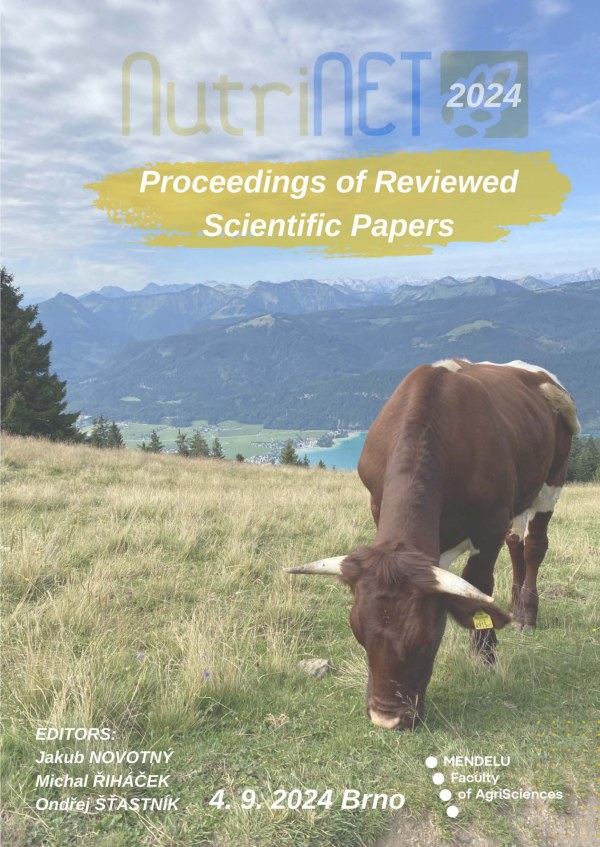
DOI: 10.11118/978-80-7509-994-5-0037
THE USE OF TRITORDEUM IN BROILER CHICKENS DIET AND ITS EFFECT ON PERFORMANCE PARAMETERS
- LUKÁŠ ČUMPLÍK1, JAKUB NOVOTNÝ1, ONDŘEJ ŠŤASTNÍK1
- 1 Department of Animal Nutrition and Forage Production, Faculty of AgriSciences, Mendel University in Brno, Zemedelska 1, Czech Republic
The aim of the experiment was to investigate tritordeum and its potential use in broiler nutrition. The experiment included 90 broilers of the Ross 308 hybrid, divided into 3 groups with 5 replications each. The broilers were fed with 3 feed mixtures (T0, T5, and T40) containing different proportions of tritordeum for 36 days. Feed mixture T0 was mainly composed of corn, wheat, and soybean meal without tritordeum. Feed mixture T5 contained the same components as mixture T0, but it contained 5% of tritordeum. The feed mixture T40 contained 40% tritordeum. Throughout the entire fattening period, feed consumption and live weight gain were recorded, droppings were collected to determine the digestibility of nutrients. At the end of the experiment, the quality of the carcass was also evaluated. The results of the experiment did not show any significant statistical differences between the feed mixtures in terms of feed consumption, feed conversion, live weight gain, or the yield of main meat parts (P>0.05). However, significant statistical differences were found when comparing the feed mixtures in terms of nitrogen retention (P < 0.05). The highest nitrogen retention was observed in feed mixture T5 (67.96%) and the lowest in feed mixture T0 (65.13%). Research has shown the suitability of using tritordeum grain in the nutrition of broilers without any negative impact on production parameters or health. There is an assumption that a certain proportion of tritordeum in the feed mixture may lead to higher nitrogen retention in the organism. As a crop resistant to warmer and drier conditions, tritordeum could potentially replace some traditional cereals in the future. It is important to continue studying new non-traditional feeds in animal nutrition to determine their impact on the organism.
Keywords: alternative feeds; global warming; nitrogen retention, poultry nutrition; Ross 308
pages: 37-47, online: 2024
References
- Aviagen group (2019a): Broiler: Performance objectives. In: Aviagen® [online]. Available at: https://en.aviagen.com/assets/Tech_Center/Ro ss_Broiler/Ross308-308FF-BroilerPO2019-EN.pdf
- Aviagen group (2019b): Broiler nutrition specifications. In: Aviagen® [online]. Available at: http://eu.aviagen.com/language-minisite/show/cz
- Ávila, C.M.; Rodríguez-Suárez, C.; Atienza, S.G. Tritordeum (2021): Creating a New Crop Species-The Successful Use of Plant Genetic Resources. Plants 2021, 10, 1029. Available at: https://doi.org/10.3390/ plants10051029
 Go to original source...
Go to original source... - De Caro, S., Venezia, A., Di Stasio, L., Danzi, D., Pignone, D., Mamone, G., Iacomino, G. (2024): Tritordeum: Promising Cultivars to Improve Health. Foods 2024, 13, 661. Available at: https://doi.org/10.3390/ foods1305066
 Go to original source...
Go to original source... - Martín, A., Alvarez, J. B., L., Martín, M., Barro F., Ballesteros, J. (1999): The Development of Tritordeum: A Novel Cereal for Food Processing. Journal of Cereal Science 30, 1999, 85-95 s. Available at: https://www.sciencedirect.com/science/article/abs/pii/S0733521098902351
 Go to original source...
Go to original source... - Paznocht, L., Kotíková, Z., Šulc, M., Lachman, J., Orsák, M., Eliášová, M., Martínek, P. (2018): Free and esterified carotenoids in pigmented wheat, tritordeum and barely grain. Food Chemistry 240, 670-678 s. Available at: https://www.sciencedirect.com/science/article/abs/pii/S0308814617312761?via%3Dihub
 Go to original source...
Go to original source... - Stupka, R. a kolektiv (2013): Chov zvířat. 2. vydání, Praha: Powerprint, 2013, 289 s. ISBN 978-80-87415-66-5.


